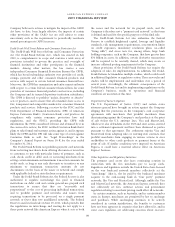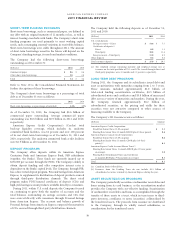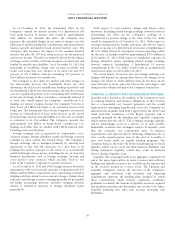American Express 2011 Annual Report Download - page 34
Download and view the complete annual report
Please find page 34 of the 2011 American Express annual report below. You can navigate through the pages in the report by either clicking on the pages listed below, or by using the keyword search tool below to find specific information within the annual report.
AMERICAN EXPRESS COMPANY
2011 FINANCIAL REVIEW
The receivables and loans being securitized are reported as
assets on the Company’s Consolidated Balance Sheets and the
related securities issued to third-party investors are reported as
long-term debt.
Under the respective terms of the securitization trust
agreements, the occurrence of certain triggering events could
result in establishment of reserve funds or, in a worst-case
scenario, early amortization of investor certificates. During the
year ended December 31, 2011, no triggering events occurred
that would have resulted in funding of reserve accounts or early
amortization.
The ability of issuers of asset-backed securities to obtain
necessary credit ratings for their issuances has historically been
based, in part, on qualification under the FDIC’s safe harbor rule
for assets transferred in securitizations. In 2009 and 2010, the
FDIC issued a series of changes to its safe harbor rule, with its
new final rule for its securitization safe harbor, issued in 2010,
requiring issuers to comply with a new set of requirements in
order to qualify for the safe harbor. Issuances out of the Lending
Trust are grandfathered under the new FDIC final rule. The trust
for the Company’s cardmember charge receivable securitization
(the Charge Trust) does not satisfy the criteria required to be
covered by the FDIC’s new safe harbor rule, nor did it meet the
requirements to be covered by the safe harbor rule existing prior
to 2009. It was structured and continues to be structured such
that the financial assets transferred to the Charge Trust would
not be deemed to be property of the originating banks in the
event the FDIC is appointed as a receiver or conservator of the
originating banks. The Company has received confirmation from
Moody’s, S&P and Fitch, which rate issuances from the Charge
Trust, that they will continue to rate issuances from such trust in
the same manner as they have historically, even though the
Charge Trust does not satisfy the requirements to be covered by
the FDIC’s safe harbor rule. Nevertheless, one or more of the
rating agencies may ultimately conclude that in the absence of
compliance with the safe harbor rule, the highest rating a Charge
Trust security could receive would be based on the originating
bank’s unsecured debt rating. If one or more rating agencies
come to this conclusion, it could adversely impact the
Company’s capacity and cost of using its Charge Trust as a
source of funding for its business.
LIQUIDITY MANAGEMENT
The Company’s liquidity objective is to maintain access to a
diverse set of cash, readily-marketable securities and contingent
sources of liquidity, such that the Company can continuously
meet expected future financing obligations and business
requirements for at least a twelve-month period, even in the
event it is unable to raise new funds under its regular funding
programs. The Company has in place a Liquidity Risk Policy that
sets out the Company’s approach to managing liquidity risk on
an enterprise-wide basis.
The Company incurs and accepts liquidity risk arising in the
normal course of offering its products and services. The liquidity
risks that the Company is exposed to can arise from a variety of
sources, and thus its liquidity management strategy includes a
variety of parameters, assessments and guidelines, including but
not limited to:
폷Maintaining a diversified set of funding sources (refer to
Funding Strategy section for more details);
폷Maintaining unencumbered liquid assets and off-balance sheet
liquidity sources; and
폷Projecting cash inflows and outflows from a variety of sources
and under a variety of scenarios, including contingent liquidity
exposures such as unused cardmember lines of credit and
collateral requirements for derivative transactions.
The Company’s current liquidity target is to have adequate
liquidity in the form of excess cash and readily-marketable
securities that are easily convertible into cash to satisfy all
maturing long-term funding obligations for a 12-month period.
In addition to its cash and readily-marketable securities, the
Company maintains a variety of contingent liquidity resources,
such as access to undrawn amounts under its secured financing
facility and the Federal Reserve discount window as well as
committed bank credit facilities.
As of December 31, 2011, the Company’s excess cash and
readily-marketable securities available to fund long-term
maturities were as follows:
(Billions) Total
Cash $ 17.9(a)
Readily-marketable securities 0.9(b)
Total Liquidity Portfolio 18.8
Less:
Short-term obligations outstanding 0.6(c)
Cash and readily-marketable securities available to fund maturities $ 18.2
(a) Includes $24.9 billion classified as cash and cash equivalents, less $7.8 billion
of cash available to fund day-to-day operations. Cash as shown in the table
above also includes $101 million classified as other assets on the Company’s
Consolidated Balance Sheets, which is held against certain forthcoming
asset-backed securitization maturities and $750 million classified as other
receivables on the Company’s Consolidated Balance Sheet, which relates to
readily marketable securities that matured on December 31, 2011, but which
did not settle until January 3, 2012. The $17.9 billion represents cash
residing in the United States.
(b) Consists of certain available-for-sale investment securities (U.S. Treasury
and agency securities and government-guaranteed debt) that are considered
highly liquid.
(c) Consists of commercial paper.
32
























